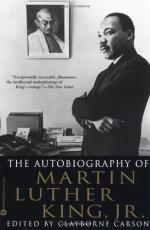
|
| Name: _________________________ | Period: ___________________ |
This test consists of 15 multiple choice questions and 5 short answer questions.
Multiple Choice Questions
1. On what day was President Kennedy assassinated and Lyndon B. Johnson sworn in as President?
(a) 22 November 1963.
(b) 27 November 1963.
(c) 17 November 1963.
(d) 12 November 1963.
2. King assessed the summer of 1963 when he noted it was what?
(a) An insurgency, not merely an insurgent.
(b) A revolution, not merely a revolt.
(c) A war, not merely a battle.
(d) A struggle, not merely an uprising.
3. King sought as his legacy justice, he was good to both the oppressed and the poor, and strove to do right even when he was what?
(a) Adamant.
(b) Resolute.
(c) Wrong.
(d) Militant.
4. Following a press conference at the U.S. Senate, when was the only encounter King had with Malcolm X?
(a) On 16 May 1964.
(b) On 26 March 1964.
(c) On 6 June 1964.
(d) On 5 April 1964.
5. A dynamite blast killed how many young black girls in Sunday school at Birmingham's 16th Street Baptist Church on 15 September 1963?
(a) 6.
(b) 2.
(c) 8.
(d) 4.
6. What did the violence in Los Angeles achieve?
(a) The hardening of white resistance.
(b) Heightened white compassion.
(c) An increase in white understanding.
(d) The escalation of white empathy.
7. King sought help from President Kennedy who met civil rights leaders on what date and convinced them something good would occur?
(a) 25 September 1963.
(b) 3 October 1963.
(c) 30 September 1963.
(d) 19 September 1963.
8. Where was a plot by a guerrilla group on King's life discovered during the summer of 1964?
(a) In Alabama.
(b) In Florida.
(c) In Georgia.
(d) In Mississippi.
9. Widespread racial violence between 11-15 August 1965 in Los Angeles, California, resulted in how many deaths?
(a) Over 30.
(b) Less than 10.
(c) Between 20-29.
(d) Between 10-19.
10. When did the leader of SNCC ignite controversy when he used the Black Power slogan?
(a) On 10 September 1966.
(b) On 14 July 1966.
(c) On 16 June 1966.
(d) On 12 August 1966.
11. The movement entered what area of Los Angeles which was occupied by the National Guard?
(a) Westside.
(b) Watts.
(c) Hollywood.
(d) Wilshire.
12. Why was the Black Power political phrase viewed as hypocritical?
(a) It advocated using same tools of oppression as were used against them.
(b) It focused on the means used by blacks, not on the goals they sought.
(c) It started with a "nonviolent" group leader but then advocated racial "power".
(d) It claimed moral standards to which their own behavior did not conform.
13. King said one had to get one's heart right with God, and while not having attained the highest peak or realized all one's dreams, he did what?
(a) "Approached the goal honestly."
(b) "Tried."
(c) "Was committed."
(d) "Achieved some success."
14. What did King organize with Chicago's Mayor R. Daley and others on 26 August 1967?
(a) The Summit Agreement.
(b) The Nonviolence Agreement.
(c) The Amicability Agreement.
(d) The Desegregation Agreement.
15. How did King respond to President Kennedy's having called Coretta over Easter weekend?
(a) Via letter.
(b) Via telegram.
(c) Via postcard.
(d) Via telephone.
Short Answer Questions
1. After he explained why he was responding to their letter, what was the first item King addressed?
2. On 26 July 1965 King led a march on Chicago City Hall and spoke before a rally sponsored by which organization?
3. In his letter to the clergy, King described Birmingham as likely the most thoroughly segregated city where?
4. Why did King maintain that those who set bombs on 11 May 1963 had selected a night and time during which customers were leaving closing bars in a black neighborhood?
5. King believed that the poor in Los Angeles saw the riots as their only means of doing what?
|
This section contains 620 words (approx. 3 pages at 300 words per page) |

|




